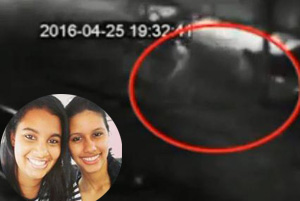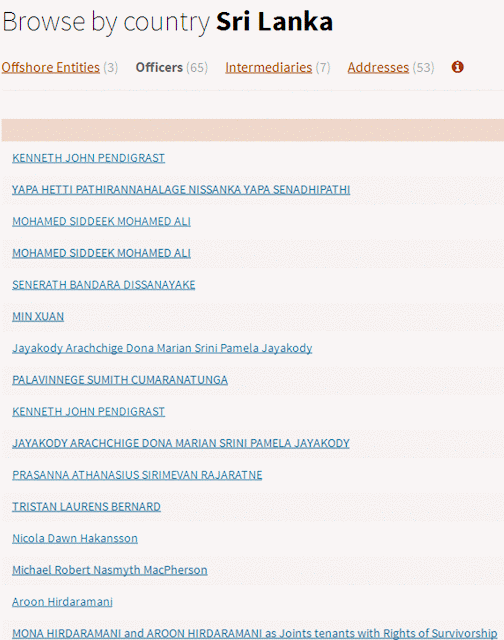The Panama Papers affair has widened, with a huge database of documents relating to more than 200,000 offshore accounts posted online. The database became accessible from 18:00 GMT at offshoreleaks.icij.org
The papers belonged to Panama-based law firm Mossack Fonseca and were leaked to a German newspaper by a source simply known as "John Doe".
The company denies any wrongdoing.
"We do not intend to suggest or imply that any persons, companies or other entities included in the ICIJ Offshore Leaks Database have broken the law or otherwise acted improperly" the ICIJ said, pointing out that there were legitimate uses of offshore companies.
The names of Sri Lankan companies and officers are given below.
Avant Garde
We publish below the list of all the persons connected to Sri Lanka published in ICIJ database;
Yapa Hetti Pathirannahalage Nissanka Yapa Senadhiathi – Avant Garde Pte Ltd
Y H P Kithsiri Manjula Kumara Yapa – Avant Garde Pte Ltd
Senerath Bandara Dissanayake – Avant Garde Pte Ltd
Prasanna Athanasius Sirimevan Rajaratne – Avant Garde Pte Ltd
Kenneth John Pendigrast – PASKEVILLE TRADING LTD
Kenneth John Pendigrast – SCATOLA FINANCE LTD.
Mohamed Siddeek Mohamed Ali – KALIN INTERNATIONAL COMPANY LIMITED
Mohamed Siddeek Mohamed Ali – KALIN INTERNATIONAL COMPANY LIMITED
Min Xuan – LENZSKI INTERNATIONAL LTD.
Jayakody Arachchige Dona Marian Srini Pamela Jayakody – GRAND RISE INDUSTRY LTD
Jayakody Arachchige Dona Martin Srini Pamela Jayakody – Lucky Stone Indus Ltd.
Palavinnege Sumith Cumaranatunga – EMPIRE STAR HOLDINGS LTD.
Tristan Laurens Bernard – Hotel IQ International Ltd.
Nicola Dawn Hakansson – NETWORK LIMITED
Michael Robert Nasmyth MacPherson – KACHINE LIMITED
Aroon Hirdaramani – Brown International Limited
Mona Hirdaramani and Aroon Hirdaramani as Joints tenants with Rights of Survivorship – STONECROFT INVESTMENTS INC.
Arun Prakash Mahtani – PASSION CHINA LIMITED
Mukesh Khubchand – ADVANI INVESTMENTS LIMITED
NG Yin Peng – GENIUS.COM LTD.
Simon Finch – BEST CHEERS LIMITED
Christopher Rohan Martin -Trump Trading Limited
list of intermediaries (the lawyers and service providers who help set up or act as the registered agents for the offshore companies)
SIMON PAUL FINCH – BEST CHEERS LIMITED – FLAT 8B; CEYLINCO SEYLAN TOWER; 90 GALLE ROAD; COLOMBO 5; SRI LANKA.
ASIA CAPITAL LIMITED – 21- 01 – West Tower, World Trade Center – Colombo -1
ADVANTEC NETWORK SYSTEMS PVT. LTD. – OVERSEAS FINANCE LIMITED, 7/11, Liberty Plaza, Duplication Road, Colombo 3.
List of offshore entities (these are the companies, trusts, foundations and more)
BEST CHEERS LIMITED – SIMON PAUL FINCH FLAT 8B; CEYLINCO SEYLAN TOWER; 90 GALLE ROAD; COLOMBO 5; SRI LANKA.
TECLLOYD LTD. – ASIA CAPITAL LIMITED – 21- 01 – West Tower, World Trade Center – Colombo -1
OVERSEAS FINANCE LIMITED – ADVANTEC NETWORK SYSTEMS PVT. LTD., 7/11, Liberty Plaza, Duplication Road, Colombo 3.
 |
| Sri Lankans In Panama Papers: Full List |
















